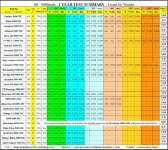flat tire said:
DogDipstick said:
This is such a troll. The question was alternatives to MULTISTAR and you post a spreadsheet exclusively of high C-rate batteries. None of those are in the same class as multistar. If HRB has an offering in that category that was not made clear.
I aint trolling.
Volume is negligible, and if you ask for a recommendation for a battery that can handle the use, I recommend the ones my friends have had success with at a reasonable price. Like I said, I fit 25 Ah of 5000mAh store bought lipos in my bike, before, and know what ou can fit, see the dimensions, and have experience in the circles of hobbies-ts whom happen to kill lesser lipos... such as Multistars.
You asked for a good battery, that would fit on a bike, have the ( similitude in ) sizes that fit in triangle bags, and not die with a hobbyist that want to push the wattage without fail.
HRB is cheap, , well reviewed, atm on Amazon ( same price as the MS, ~50c/Wh... ), near the same volume ( fit 25Ah in a bag) and will not die when hit with 10Kw, unlike the ( lesser quality) Multistars. Plus they can fly 10Kw RC helicopters, something the manufacturer of Multistars explicitly did not expect from their product.. for the same price. The power AND the capacity, right there, for the same price, instead of the JUST the capacity, and a well known LACK of power.
Be proud of whatever battery you have if you like it, but I have my experience, and the knowledge of others also.
They sell 8Ah packs, too, HRB does.. but they are not as cheap as the 5ah packs cause the 5Ah are so poplular in that size... loads of applications...


